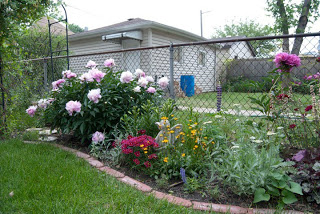
There are many reasons you might have patchy grass. I have seen everything from having sun grass where a tree has grown so big that the lawn in that area now needs shade seed to sporadic watering. Patchy grass could be from animals scratching, burrowing, and urinating. The most common reason for patchy grass that I have seen is insects, most notably, grubs. Whatever the reason, the best defense is a strong root structure to your lawn. A healthy lawn can combat critters and insects. I use a lot of Jerry Baker’s advice when taking care of my lawn.
1: Dethatch in the spring with a stiff rake
– Get rid of all the dead grass under the green stuff and throw the debris in your compost pile
2: Aerate the lawn in early spring, and throughout the summer
– Jerry Baker advises getting some thrift store golf spikes and wearing them in the yard during yard work. This aerates the soil, allowing the roots to breathe and grow. We just grab our pitchfork and poke holes in the yard in early spring while the yard still looks bad.
3: Fertilize and put down GrubX every two weeks
– I would even recommend putting it on the snow in February and March-once it gets to be 60˚, grubs hatch and it is a losing battle all season.
4: Epsom salt. Epsom salt, Epsom Salt
– Sprinkle Epsom salt evenly once a month. Epsom salt greens up the yard promotes root structure, and broadens the leaf. I have heard that Epsom salt is also bad for slugs. If rain is coming, I try and give a coating of Epsom Salt the day before, so the rain gives it a good soak, and the grass drinks it all up. I also try and put some on the spring snow, too. As it slowly melts, it will give a boost to spring grass.
5: Consistent water
– Grass likes water-lots of it. Get your sprinkler going, especially during the hottest months. Try to do it in the morning, and avoid the heat of the afternoon where water will just scorch the grass. You can do early evening too, but I try and avoid night because too much night watering may cause mold and fungus problems. Think about England, and how misty and wet it is all the time, and cool mornings and evenings. Now think of the green hills and moors. That’s what grass likes. Consistent water and cooler, mild temps.
6: Know your acidity, and use lime if you have slightly acidic soil
– We bought our retirement dream cottage in Michigan to slowly fix up until we were ready to pull up stakes and start our golden years. We’ve been having a heck of a time with the grass there. Our neighbor has grass a golf course would envy. One day we asked him how he does it. The only thing he does differently than we do is that he uses a hand spreader and sprinkles lime all over the grass every few weeks. Michigan is known for acidic soil, and after we did a test, we discovered we did in fact have slightly acidic soil. A PH test is very easy to do, and inexpensive. You can pick them up at any garden center or DIY big box store. Check your PH, and if you have slightly acidic soil, start using some lime to make the soil’s PH more palatable to grass.
6: Mow high
Homeowners have a tendency to mow lawns far too short. When the grass is too short, it allows for more aggressive plants (I mean “weeds”) to compete for the sun and other natural resources. Then they soon takeover, weakening the root structures of the turf, and finally outpacing it all together. Cutting the grass too short also causes too much stress for the turf, and allows the grass to dry out quicker. Cutting grass blades with your lawnmower a little longer will crowd out competing plants, and block sunlight from them, as well. Ideally cut the blades of grass so they are 3 1/2-4″ high, and try to never cut more than 1/4 of the height of the grass at any given time.
If you MUST have grass, try and not use chemicals so that our bees and other pollinators can thrive.
UPDATED Oct. 2020
- Sugar-Free, Low-Carb, Olive Oil Chocolate Hazelnut Tart - February 18, 2023
- Easy Slow Cooker French Onion Soup - November 28, 2022
- Recipe: Chicken Vindaloo with Whole Foods Vindaloo Curry Powder - January 22, 2022





